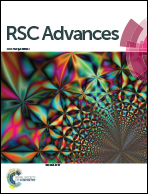Highly flexible and transparent metal grids made of metal nanowire networks†
Abstract
This work reports a new flexible transparent conductive electrode architecture based on solution-processed silver nanowire percolation metal grids (AgNW MGs). The AgNW MGs are stably fabricated by a well-established wet coating method and subsequent selective chemical etching of the AgNWs. The fabricated AgNW MGs exhibit good optoelectronic performance with sheet resistances of 9.9 Ω sq−1 and 14.7 Ω sq−1 at transmittances of 84.7% and 88.7%, respectively. The integration of percolated NW networks into the micro-grid structures also enables reproducible fabrication and controllable and reversible performance. The electrical robustness is greatly improved by incorporating a conductive polymer over-coating.


 Please wait while we load your content...
Please wait while we load your content...